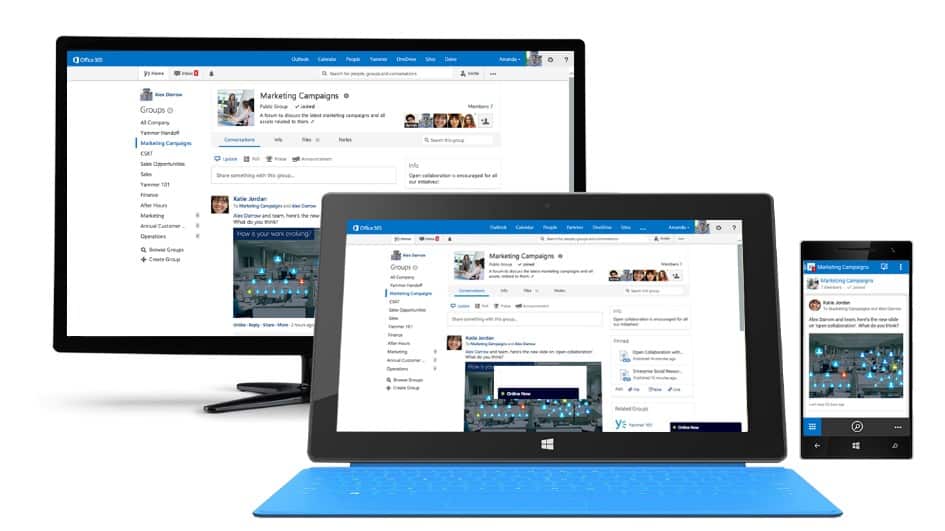We all know that mobile is big. Actually, it’s huge. Here are some stats to convey the “hugeness”:
- 80% of Internet users worldwide own a smartphone
- By 2016 there will be 10 billion mobile Internet devices used globally
- The number of mobile users passed the number of desktop users last year
- 89% of mobile users’ time is spent on mobile apps — 11% is spent on mobile Web
Microsoft SharePoint is also big, with 50% of U.S. companies using SharePoint Server and over 75% of Fortune 500 companies using it. Office 365’s stats are also impressive, with 80% of Fortune 500 companies making a purchase in the last 12 months, effectively sealing Office 365’s spot as Microsoft’s fastest growing commercial product in its history.
Mobile is big, SharePoint is big — but does that mean mobile on SharePoint is even bigger? As much as Microsoft might like to hear that is true, it is not. We have two significant trends: rapid mobile growth and expanding use of SharePoint and Office 365. But the reality is that mobile adoption by SharePoint users has not corresponded with the stunning growth of the mobile market. The likely reason? SharePoint does not yet offer a compelling enough mobile experience.

Mobile Solutions
Solutions can appear on a mobile device via a downloadable app or via a Web browser. The former typically offers a mobile-friendly experience, especially in terms of aesthetics and functionality. Custom-made mobile apps are capable of presenting robust user experiences without sacrificing look and feel. The downside is that they are standalone solutions that require dedicated development and device-specific code (e.g., Android, iOS, Windows Phone). They may look and work perfectly, but a significant investment is required to realize a mobile app deployment at the enterprise level.
The second approach, using a Web browser, offers cross-device accessibility and consumes fewer mobile resources: information is processed on a server and presented in a browser environment. The rise of HTML5 has enabled browser-based solutions to become device-agnostic, which simply means that the solution’s appearance is consistent across multiple devices, whether it’s a 7-inch Android tablet, a 14-inch laptop, or a 4.7-inch iPhone 6. The downside is that desktop-based solutions frequently don’t convert very well to mobile usage. Functionality and aesthetics are about more than successfully “shrinking down” content to a smaller screen size; the application has to work seamlessly, and look good while doing it, and that’s been a major challenge for solutions taking the HTML5 / browser route.
Microsoft’s Mobile Implementation in SharePoint
Microsoft has elected for the latter option: deploying SharePoint to mobile devices via a browser experience. The company started testing the mobile waters with SP2007 and continued with SP2010. Both of those pre-HTML5 attempts were a bit lacking in the beauty and functionality departments. Mobile users only had access to documents and list items with no real capability for interaction. For the most organizations, the available functionality was not viable enough to make mobile usage a realistic option.
SP2013 was the first version to be able to take advantage of HTML5, which enabled Microsoft to present a reasonably workable SharePoint interface that could be used on multiple devices. A new HTML5-powered “contemporary view” added some much-needed touch-screen interaction, which enabled users to more easily access wikis, Web parts, lists, and document libraries. Push notification capabilities were also added, effectively allowing users to receive alerts when content was modified.
SharePoint 2016 Mobile
Next year, SharePoint 2016 will be released to the public. While it’s still too early to make a judgment call, the overall opinion from the public beta seems to be that mobile functionality has improved, but only slightly. HTML5 is more widely implemented and content should be a bit easier to manage. It’s an improvement, but doesn’t seem to be the homerun that users were looking for.
From a Big Picture perspective, seamless delivery of a made-for-desktop solution to the mobile space via a browser is a lot to expect. This approach is heavily reliant on current technology — as mobile browser experiences improve, so will SharePoint’s mobile capabilities.
In the interim, SharePoint enthusiasts have turned to third-party vendors for add-ons that render SharePoint on mobile devices. These solutions are still bound by SharePoint and browser limitations, but generally are able to provide a more engaging user experience than “out-of-the-box” SharePoint.
—
Crow Canyon Systems has 16 years of experience assisting organizations in leveraging their existing infrastructure, rather than requiring new hardware & technologies. We specialize in building upon your collaboration platforms, such as SharePoint and Office 365, in order to give your Help Desk and Support Staff the tools they need to provide assistance without the need for additional infrastructure.
Want to learn more about how our solutions can transform your SharePoint experience? Give us a call at 1-888-706-0070 or contact us by e-mail at sales@crowcanyon.com

